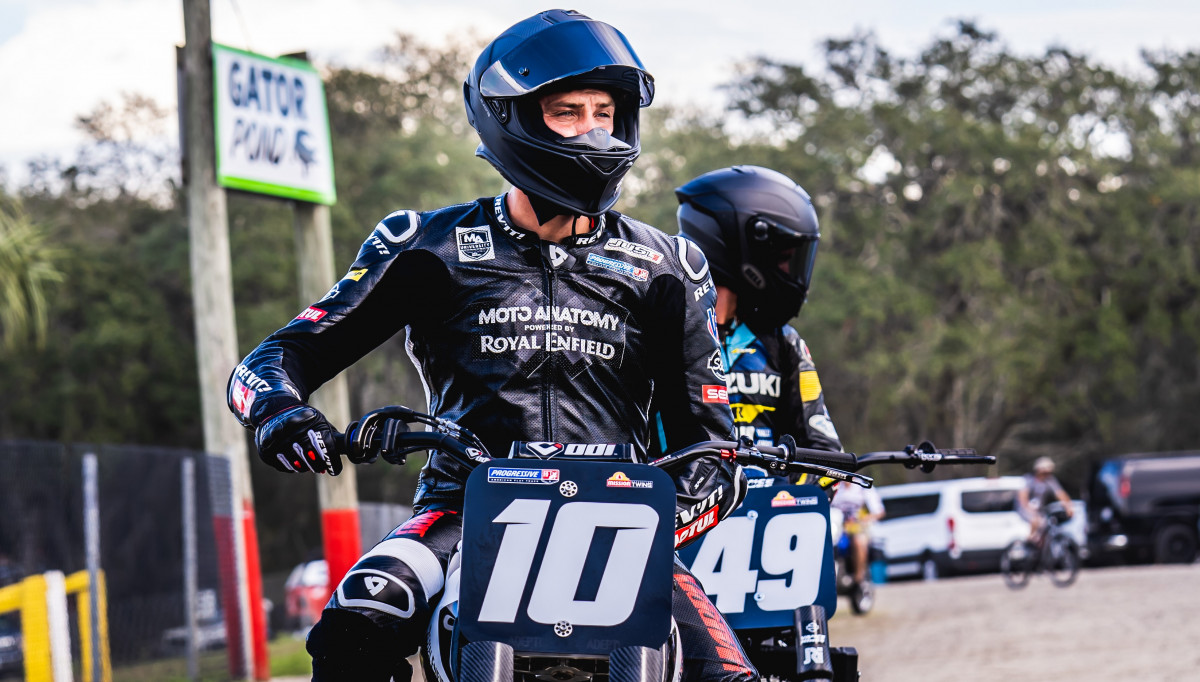
Lewis Goes the Extra Mile with Royal Enfield
Now early in its third season, it’s difficult to view Royal Enfield’s entrance onto the Progressive American Flat Track scene as anything but a success.
Thrown into a world-caliber battleground that is as idiosyncratic as it is competitive with basically no modern race history to speak of, Royal Enfield’s Twins FT is already a Mission Production Twins presented by Vance & Hines Main Event winner twice over.
While outward observers and Royal Enfield brass are suitably impressed, the man at the center of the effort remains less than fully satisfied.
Johnny Lewis is not just the pilot for the Moto Anatomy X Royal Enfield effort, he’s also the de facto team manager, lead developer, brand ambassador, occasional model, and pretty much any other role he or Royal Enfield North America can think up to help spread the brand’s gospel in the United States.
But the best way he can do that is by contending for wins with regularity, something he feels should already be taking place considering the unrealized potential that remains in both himself and the platform.
Wanting more despite carrying a nine-race streak of sixth or better is testament to how far the project has come in short order. 2022 marks the program’s first full campaign, and as such, it’s rapidly approaching its next milestone when the series visits the Mission Red Mile presented by Indian Motorcycle of Lexington doubleheader on May 28-29.
Initially hindered by an unfortunate combination of too little power and too much weight, the Miles were to be actively avoided when the bike first debuted. But Lewis is cautiously optimistic they’ve now got the firepower for wage wide-open, triple-digit warfare.
“The base motor that comes out of the INT 650 starts off at 47 horsepower,” Lewis said. “And most people know we're racing against motors with 90-some horsepower – some of the Yamahas even have upward of 100.
“From the start, we were fighting a battle of trying to develop a motor that has to be double the horsepower of where it starts. Is the crank going to be strong enough? Is the rod going to be strong enough? We've basically had to change almost everything except for the bottom end, which is pretty much stock. In theory, we're asking this motor to give us probably about 3500 more rpm compared to stock, if not more. We're asking a lot out of this thing.
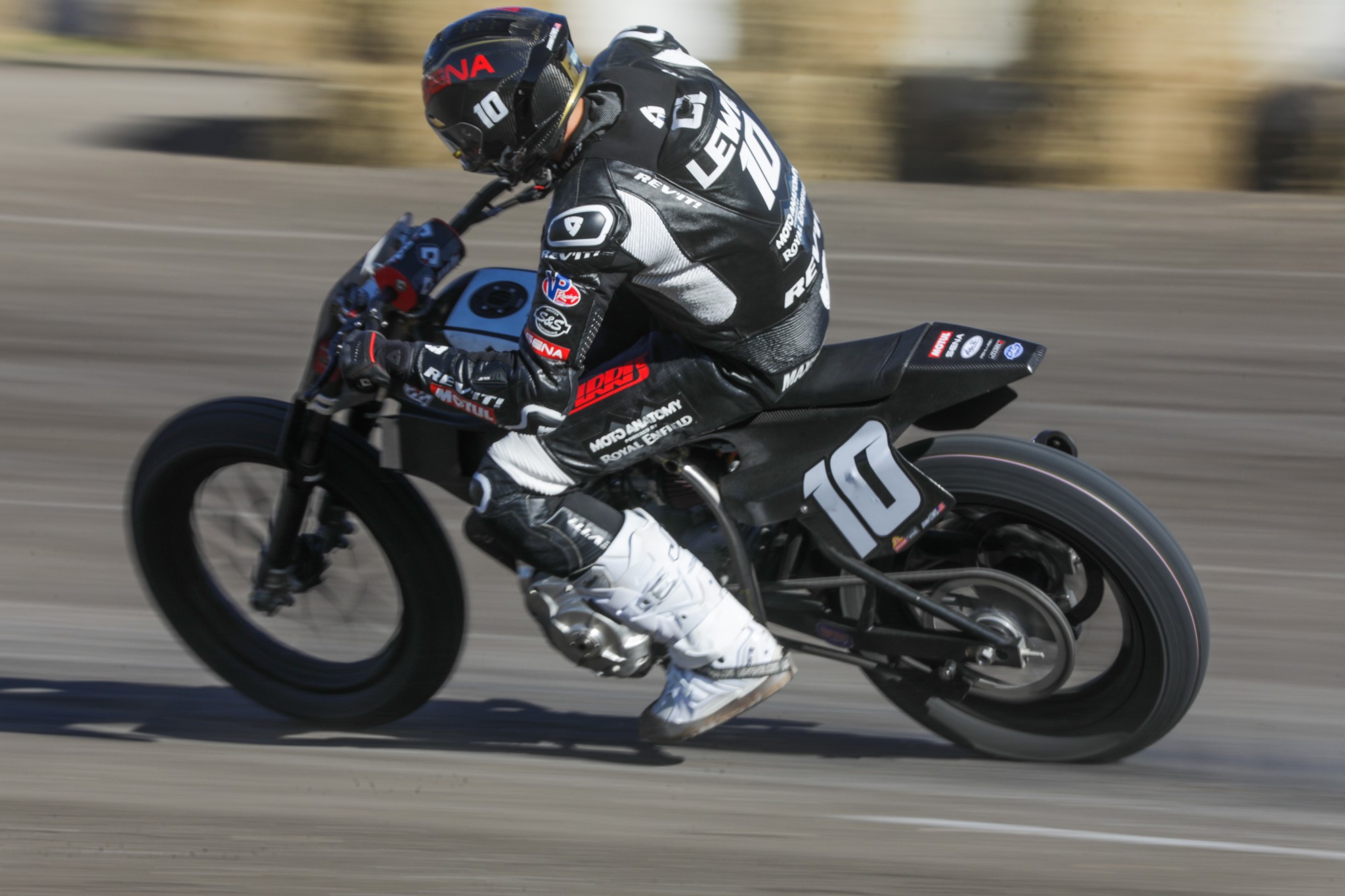
“The first year, when they sent it over for the 2020 season, we were mid-70s horsepower. And we ran that and won at Daytona. You didn't need power there because it was a smaller Short Track. You just needed to make the power hook up.
“Coming into 2021, we were able to get it to the mid-80s over the winter by changing a lot of stuff, and we were able to win at Lima with that.
“It's amazing because now in the last couple of months, we have almost reached our goal of doubling the horsepower. Every dyno reads differently, but we're in the low 90s. And honestly, peak power is not really the most important thing. I've ridden bikes that had 110 horsepower – KTM 990 and Ducatis and stuff – and that peak power didn't matter all that much for that one second you could use it down the straight once you got the thing hooked up and in a straight line.
“It's that power from 7000 rpm up to 9000-10,500. And recently we’ve made massive gains from low-to-midrange power. That's exciting for me.
“I think we're going into this first Mile with pretty good expectations knowing where we're at. We were able to gain even more power since I-70, just taking the time and running the thing on the dyno and working on the exhaust with S&S to figure out what it likes and where the power is now.”
If Lewis speaks like a proud papa, it’s because, while integral in the development process from very early on, he’s taken on more and more responsibility as the program has continued to evolve.
He said, “The first year they kind of sent over a package. The next year they started letting us do a little more ourselves. And now we're on to the third year, and they're sending us parts based on what we have developed over here and then told them, 'Yep, we need these, can you make them?' They are sending the parts over, but we're doing 90% of the development over here in the States. And a lot of it has been during race weekends.
Unfortunately, that’s been the reality due to poor luck with weather conditions – a fact that’s very much been the case during race weekends thus far in 2022 as well.
“We've only gotten four real test days in the last 20 some months. It's tough when you get tracks that change every weekend and the size of the track and the type of soil. And obviously, this season, it's been tough with the weather conditions we've had and the tracks that we've had.
“But that whole process itself has been such a learning experience for me as one, the rider, but also pretty much the team manager too. It's a responsibility that I took on when I signed up for this gig.
“I didn't realize how much I was going to learn in such a short period of time. It's been incredible. You sit back and say, 'It's only been 20 months?' It feels like it's been five years in a lot of ways. But in other ways, it felt like that first race at Williams Grove in 2020 in September was just months ago.”
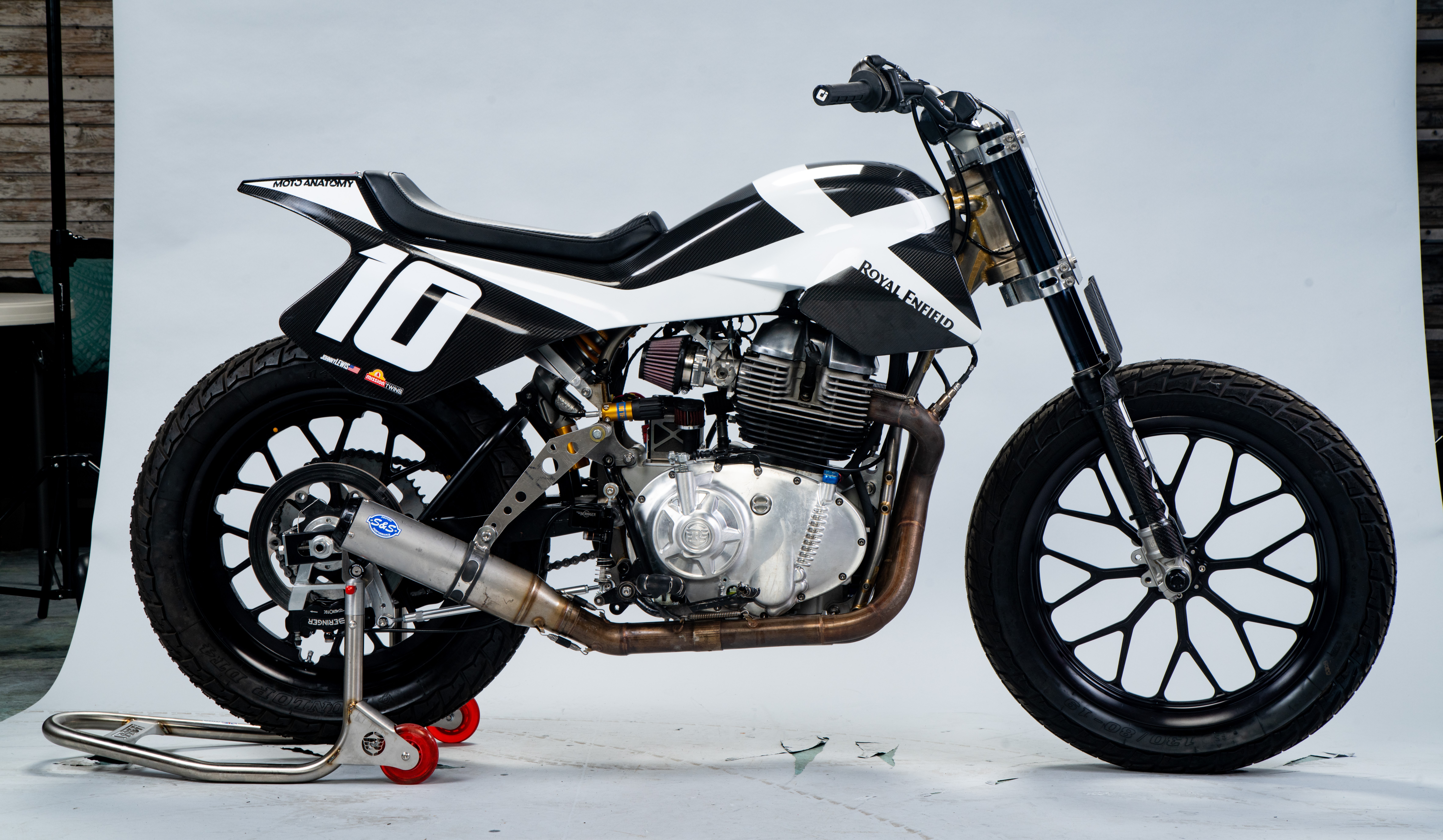
Even as the engine has added a mountain of muscle, the chassis has undergone a similar transformation. There, Lewis and the Moto Anatomy team have worked in collaboration with the famed Harris Performance, the British-based firm best known for its Grand Prix exploits that was acquired by Royal Enfield in 2015.
“(Harris) know numbers and geometry when they look at a piece of paper,” Lewis said. “What's been neat is when I start explaining to them the characteristics that I'm looking for and what the bike is doing, they are able to look at it with maybe a different terminology and say, 'Okay, I think we can get this effect.'
“We started off with one swingarm, and we changed that. And the frame we went from a linkage system to a non-linkage system. And we started eliminating some brackets to get the thing to flex more, and we cut the chassis to get more flex too..
“And then I said, ‘Guys, this is the direction I really want to go.’ We took some numbers and drew up some stuff, and they sent me a drawing on the computer and said, 'This is the chassis we're going to build for you based on the input you provided.'
“So now we’re on version 3.5 of the chassis… We were making little changes and little changes, and then we made a pretty big change this year.”
Even though Harris Performance did their homework and came into the dirt track project eyes wide open, it has still taken some effort to rewire a GP-centric mindset.
Lewis explained, “The biggest thing is it was just too stiff. They are used to the roadrace side of things. When we get to real slick clay tracks, that made it really hard to ride. Despite having some good finishes, it was a challenge.
“With the new chassis, we have more flex characteristics, and it’s lighter, so we're dropping weight at the same time. It's a heavy motor. The first bike was extremely heavy. It was 365 pounds when the weight rule is 320. Some of these Yamahas and KTMs and Kawasakis that we're racing against are at that 320 mark.
“Every day it's waking up and trying to think of something new, and those guys are amazing to work with. I say, ‘Hey, I need a degree change in my offset,’ two days later, I have it sent from England to my doorstep, and they’re the highest quality products that any flat track team has.
“Those guys make the most amazing stuff. That resource on that side of things is just incredible. If I can dream it, they can make it.”
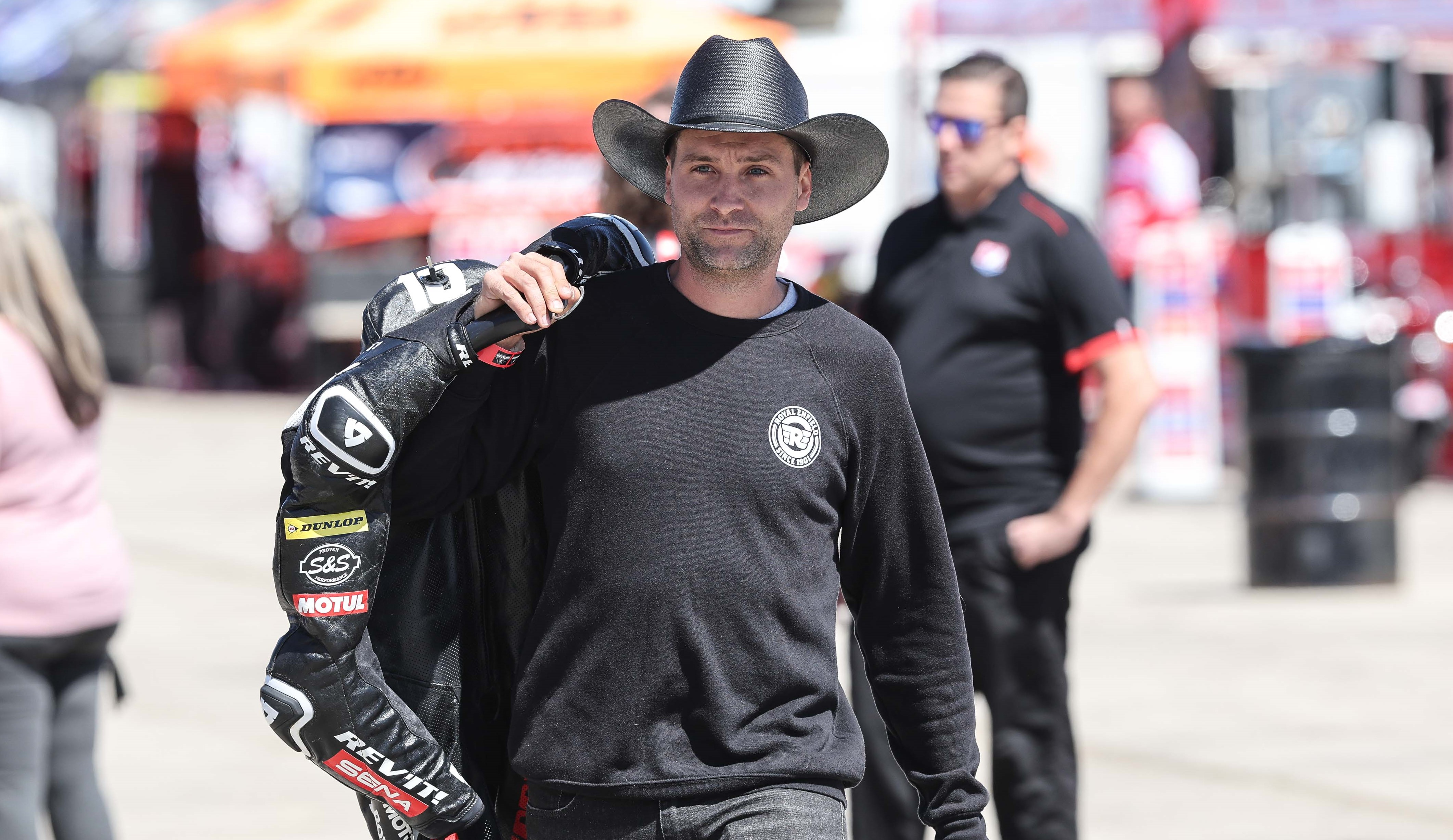
But the new pieces intended to elevate the bike to new heights don’t just come in the form of engine components and chassis bits. They’re on the personnel side of things as well.
For 2022, Lewis recruited Keith Persson, formerly the practice mechanic for some elite Supercross stars, to join the effort. The weather cancellations and abbreviated schedules that have defined the early season haven’t exactly been the ideal way to break in a mechanic new to the sport, but Lewis already recognizes their potential as a pairing.
“We’re both competitive, and the expectations are high for both of us. I've been able to learn a lot from him already. In the past, I've had other people who just pat you on the back and say, 'Hey, you're doing great.'
“He doesn't really pat me on the back. He knows what I'm capable of. We're basically the same age and we both want to do the best we can at our job. He also has that competitive side that fires me up. ‘This guy wants to win as much as I want to win... I like it.’
“He’s worked almost every day since the last race, changing motors, taking them apart. We went up to S&S and dyno'd the engine with (S&S employee and Moto Anatomy race weekend crew member) Matt Schmidt and made a couple new exhausts to find power and help me understand where to gear it to utilize that power that much more effectively.”
“Keith has taken them back apart, checking everything three times over, finding where we had a little bit of wear, trying to fix a few little things. He's trying to make these things to be as perfect as they can be for this Mile and for the rest of the season.
“I've always known how much work goes into a program, but now I’m the guy who has to make sure they aren’t just doing their jobs but also making sure they're okay. It is so much work. I also have to be the therapist going, ‘Hey, you good? I know that it's a lot of work. Do you need anything?’
“I see how much effort these guys put in. I feel like we're a team, and I need to go that extra mile with my training too.”
All of that effort has resulted in consecutive finishes of 1st, 4th, 4th, 6th, 5th, 4th, 5th, 6th, and 6th dating back to midway through last year. While commendable, continued teething issues have resulted in a plateau that’s masked their genuine caliber.
“Even days we were breaking stuff, the things we were breaking were allowing us to finish. There were a lot of races last year where we were breaking rocker arms and we'd lose a bunch of power, but we were still able to make it work.
“That shows the impressiveness of that motor. Something breaks and that thing is still running. Those stock Royal Enfields are meant just to go and ride for thousands and thousands of miles. They’re tough.
“But while we are getting these consistent finishes, it's not where I feel like me and the bike should be at the moment. There are days where everybody is stoked that we're getting top fives and top sixes. It looks great on paper, but I know we're capable of so much more.
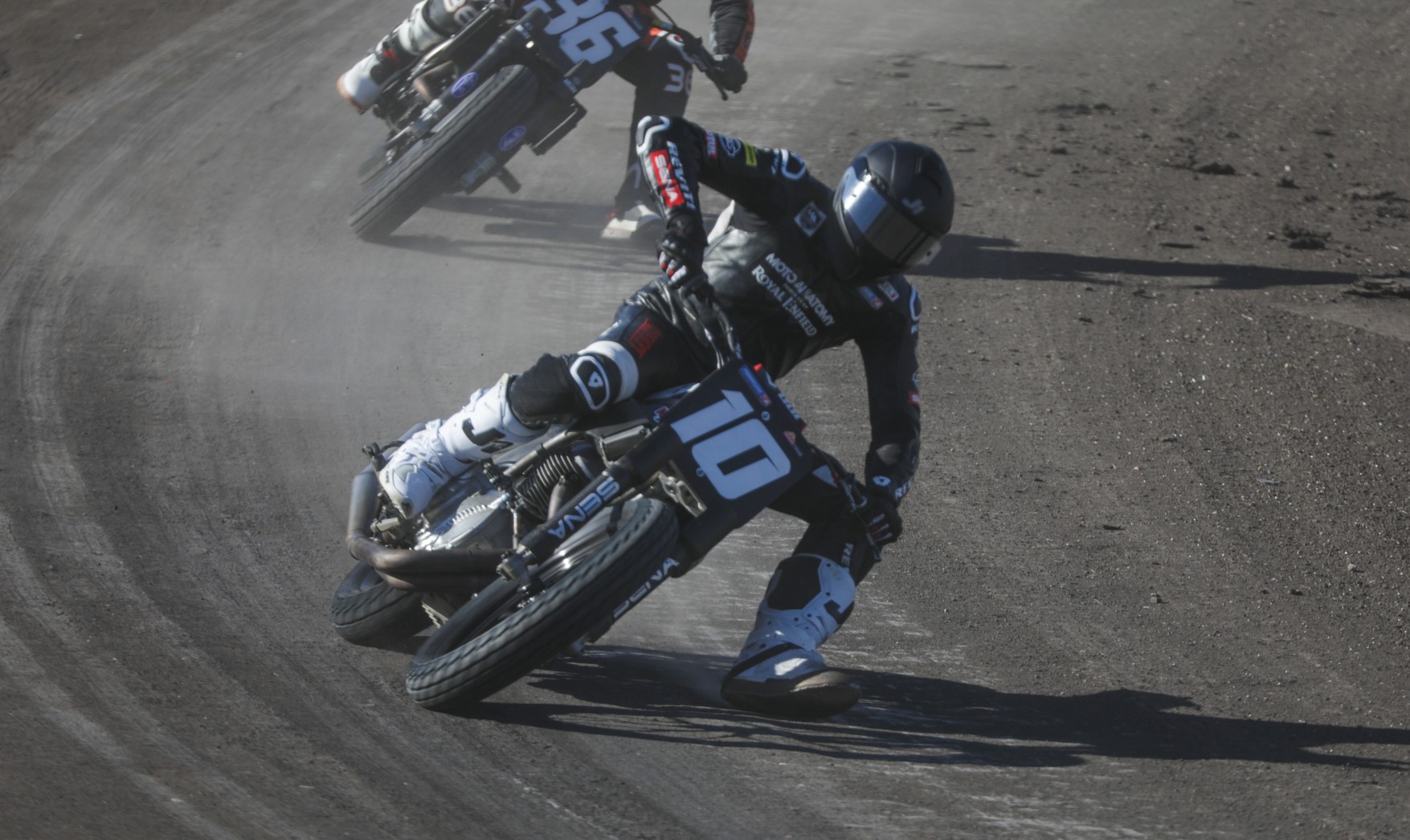
“At the end of the day, that's what's so exciting about the program. If we were out there riding at 100% and everything was going 100% and we were getting 100% out of it and still finishing fifth and sixth, it would be like, 'Okay, cool, that's where we should be at.' But what I see is, when this thing is on, and when I'm on, we should be winning races.
“Royal Enfield themself are tickled. We’ve won two races already. But I've raised my expectations higher than what they have in some ways. I've finally got a chance to show what I'm capable of, and I want to go all-in and maximize everything that I do.
“Within this time of developing this bike, we’ve won, and we’ve also had a lot of bad days where we were just breaking stuff and loading the truck up. But those bad days make those wins and those accomplishments that much sweeter. It’s been very rewarding.”
Beyond that first Mile, the next milestone will be to line up on the premier class grid for the first time. And that could come as early as the Red Mile, as Lewis is anxious to take part in the Mission Production Twins Challenge, a new twist added this season that allows the top four finishers in Mission Production Twins to participate in the Mission SuperTwins presented by S&S Cycle Main Event… and a twist Lewis helped dream up in the first place.
“I wanted to be in the last three, but my finishes haven't been there yet. I think we're close. Jesse Janisch has shown how competitive the Production Twins bikes can be against the SuperTwins. It shows that we're not as far off as some might think we are.
“I'm up for more laps. The more laps I can get on this thing the better, just to figure this thing out. It would also be great to get out there and get back running with Jared Mees and those guys that I grew up racing with.
“And it would just be a neat deal for Royal Enfield to say we made it into a Mission SuperTwins Main Event. That would be one more thing to check off the books for the history of the bike.”
It would also serve as a preview for what’s to come. Lewis is open regarding Royal Enfield’s ultimate ambition to expand the effort and compete at the sport’s highest level come 2023. In fact, those plans have already impacted the bikes development.
He explained, “We want to put a second rider on one of these bikes, and I’m the guy who's having to look around to determine who'd be capable of riding one of these bikes moving forward.
“That does throw a curve in things a little. I have to consider how the bike will work with someone else's skills, wants, and needs. With that in mind, I've had to downsize the motorcycle as far as physical size.
“We were at a race and I asked Sammy (Halbert) to come sit on it because I hadn't had any smaller riders even sit on the bike. I'm about 6’1”, and he was like, ‘How do you fit on this?’ I was like, ‘I'm tall -- my legs wrap around the tank.’ So I made changes to the new chassis with that in mind, pre-thinking about somebody else riding it too.”
If Lewis has to go small to think big, so be it. While on the surface, the Royal Enfield project comes across as a feel-good, top-five Mission Production Twins effort, in his estimation, it has the capacity to take on the best the sport has to offer in the form of a stone-cold assault on the Mission SuperTwins class next season.
“The intention is to finish out this season really good and then in 2023 and race the elite class and be a top-ten, top-five program out there with multiple riders.
“I don't see why we can’t run with the Indians or the Estenson Yamahas on any given weekend once we get to that point of building that consistency on the motor side of things and getting the fine-tuning of things down..
“That's the most encouraging part of this program – we're not at our peak.”




























